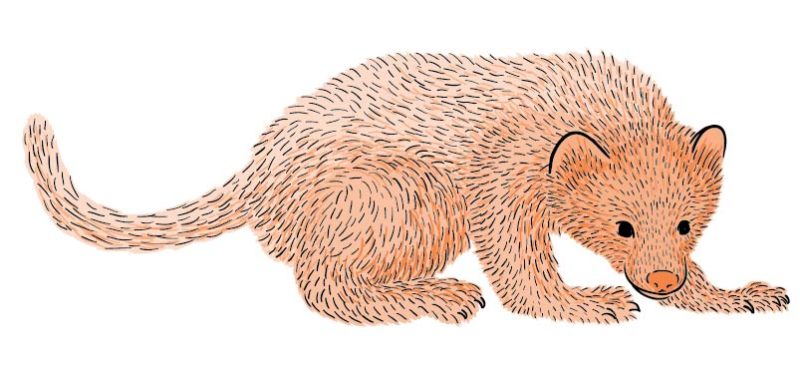FEATURES:
- Length: up to four feet
- Mass: up to fifteen pounds
- Nighttime caterwauler
- Porcupine killer
The beast was previously unknown to me. It was small yet large. It was cute yet hideous. It was shy yet it took what it wanted and attacked without provocation (see: Reddit). No one had ever seen one, but it was everywhere, this beast, nesting in forests, stalking rows of corn, circling homes and gardens, feasting on everyone’s pets. It seemed to be composed of parts appropriated from other animals: a toylike head with round ears, a snout stuffed haphazardly full of hook-like teeth, a pointlessly long and supple body, anodyne peg-like limbs nevertheless festooned with claws. It was solitary and, according to legend, at night let out a keening wail—an apoplectic demon-child in search of blood. I knew it lived near me.
I do not remember how I first learned its name: fisher cat. Or, more properly, fisher, as it is not a cat. Or: pékané (Abenaki), Pekania pennanti (classification), Pennant’s marten (English, after Thomas Pennant, a Welsh naturalist), otchoek (Cree), tha cho (Chipewyan), otochilik (Ojibwa), uskool (Wabanaki). Fishers do not fish, and it is thought that early American immigrants mistook them for polecats, a.k.a. fitches or fitcheau, in Old French, terms allegedly related to the Dutch visse, meaning “nasty,” and the Middle English fulmard, a “foul marten.” The French word for the pelt of a polecat is fiche, another possible source for the word, given the North American fur trade.
Perhaps someone said, You’ve got a lot of fishers up there, meaning where I lived: that is, in the woods, two hours south of the Canadian Border. Maybe it was a whole table of people speculating about this, about them, the fishers. I don’t know if the fascination was first someone else’s or if it was always my own; I don’t know which happened first: the googling and the YouTube-ing, or the live appearance, which occurred shortly thereafter, and which, I was later informed, perhaps by the same tableful of people, and thus, perhaps erroneously, is extremely rare.
Here are a few things I do know.
- The adult female fisher is almost always pregnant. She mates in the spring (females are the instigators of this activity). Over the next eleven months, the fertilized embryos remain dormant in the blastocyst phase until the following February, when the increase in daylight hours is believed to trigger implantation, leading to a brief, six-week gestation. Then the female gives birth and...
You have reached your article limit
Sign up for a digital subscription and continue reading all new issues, plus our entire archives, for just $1.50/month.
Already a subscriber? Sign in





